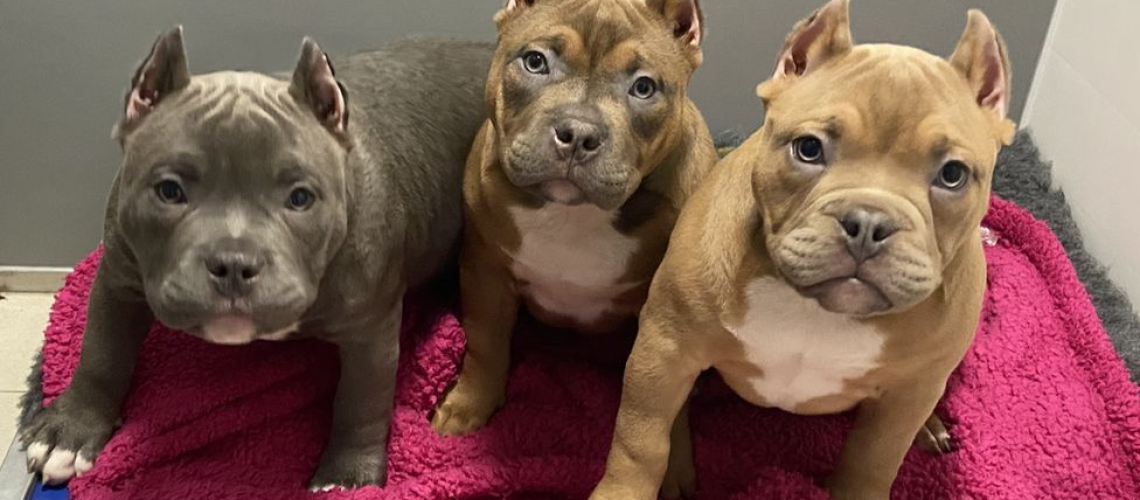Cropping puppy ears is a controversial practice that involves surgically altering the appearance of a dog's ears.
Key Takeaways:
- Cropping puppy ears is a controversial practice that involves surgically altering the appearance of a dog's ears.
- Ear cropping is mainly done for cosmetic reasons and has no medical benefits for the dog.
- The procedure can be painful and carries risks of infection, scarring, and complications during healing.
- Many countries have banned or heavily regulated ear cropping due to concerns about animal welfare.
- It is important to research and consider alternative options, such as breed selection or non-surgical ear shaping techniques, before deciding on ear cropping for a puppy.
What is Puppy Ear Cropping?
Puppy ear cropping is a surgical procedure that involves removing a part of a puppy's ears to alter their shape and appearance. This procedure is typically done on certain dog breeds, such as Doberman Pinschers, Boxers, and Great Danes.
During the procedure, the veterinarian cuts off a portion of the puppy's ears and then stitches them up in a way that makes them stand upright. This gives the dog's ears a pointed or erect look instead of their natural floppy appearance.
The History of Puppy Ear Cropping
The practice of cropping puppy ears has been around for centuries and has its origins in historical purposes. In the past, ear cropping was commonly done on working dogs to protect their ears from injuries while they were hunting or fighting.
However, over time, ear cropping has become more associated with aesthetic preferences rather than functional reasons. Some people believe that cropped ears give certain dog breeds a more assertive or intimidating look.
Cropped Ears vs. Natural Ears
- Cropped Ears: The process of ear cropping involves surgically altering the shape and position of a dog's ears. The specific technique used may vary depending on the breed and desired outcome. After healing, the dog's ears will stand upright or have a modified shape.
- Natural Ears: Dogs with natural ears have floppy or droopy ears that are not altered through surgery. These dogs retain their original ear shape and position as determined by genetics.
It is important to note that whether or not to crop a puppy's ears is a personal decision made by the owner and should be discussed with a veterinarian who can provide guidance based on breed standards and individual circumstances.
Why Do People Crop Puppy Ears?
Historical Reasons
Ear cropping in puppies has a long history and was initially performed for practical reasons. It was believed that cropped ears would prevent injuries during hunting or fighting, as the ears would be less vulnerable to bites and scratches. Additionally, certain breeds were cropped to conform to breed standards set by kennel clubs.
Aesthetic Preferences
In modern times, ear cropping is often done for aesthetic reasons. Some people believe that cropped ears give certain breeds a more assertive or intimidating appearance. There is also a perception that cropped ears enhance the dog's overall appearance and make them look more "regal" or "elegant."
List of Breeds Commonly Associated with Ear Cropping:
- Doberman Pinscher
- Boxer
- Cane Corso
- American Pit Bull Terrier
- American Bully
- Rottweiler
- Boston Terrier (historically)
List of Kennel Clubs Allowing Ear Cropping:
- American Kennel Club (AKC)
- Fédération Cynologique Internationale (FCI)
- The Kennel Club (UK)
How is Puppy Ear Cropping Done?
Puppy ear cropping is typically performed by a veterinarian under general anesthesia when the puppy is around 8-12 weeks old. The procedure involves surgically removing a portion of the outer ear, followed by shaping and suturing the remaining tissue to achieve the desired appearance. The ears are then bandaged to protect the surgical site during the healing process.
After the surgery, the puppy will require regular follow-up visits to monitor healing and ensure proper ear standing. These visits may involve changing bandages, adjusting sutures, or providing additional support to encourage proper ear positioning.
Common Techniques Used in Puppy Ear Cropping:
- Crop and Post: This technique involves removing a portion of the outer ear and using posts or splints to help shape and support the ears during healing.
- Show Crop: Show crops aim for a longer, more erect appearance by leaving more of the outer ear intact.
- Battle Crop: This technique involves a shorter crop, leaving less of the outer ear remaining.
Risks and Complications of Puppy Ear Cropping
While puppy ear cropping is a surgical procedure performed by professionals, it carries certain risks and potential complications. These can include:
Pain and Discomfort
The surgery itself can cause pain and discomfort for the puppy. They may experience soreness, swelling, or difficulty eating or drinking immediately after the procedure. Pain management medication is typically prescribed to alleviate these symptoms.
Infection
There is a risk of infection at the surgical site if proper post-operative care is not followed. Regular cleaning and monitoring for signs of infection are essential to prevent complications.
List of Signs of Infection:
- Redness or swelling around the incision site
- Pus or discharge from the incision
- Foul odor coming from the incision
- Fever or lethargy
Improper Healing or Ear Standing
In some cases, the ears may not heal properly or stand as desired. This can lead to a less aesthetically pleasing result and may require additional surgeries or interventions to correct.
List of Factors Affecting Ear Standing:
- Genetics
- Post-operative care and support
- Infection or complications during healing
- Puppy's age at the time of cropping
Potential Benefits of Puppy Ear Cropping
Proponents of puppy ear cropping argue that there are potential benefits associated with the procedure:
Breed Standard Conformity
Cropping the ears of certain breeds allows them to meet breed standards set by kennel clubs. This is important for those who wish to show their dogs in conformation events.
Reduced Risk of Ear Injuries
Historically, cropped ears were believed to provide protection against injuries during hunting or fighting. While this reasoning may no longer be relevant in modern times, some proponents still believe that cropped ears can reduce the risk of ear-related injuries.
Laws and Regulations on Puppy Ear Cropping
The legality and regulations surrounding puppy ear cropping vary depending on the country and jurisdiction. Some countries have banned the practice altogether, while others have specific guidelines and restrictions in place.
Countries Where Puppy Ear Cropping is Banned:
- Australia
- New Zealand
- Germany (with few exceptions)
- Netherlands (with few exceptions)
- Sweden
Countries with Restrictions or Guidelines on Puppy Ear Cropping:
- United States: Regulations vary by state, with some states allowing the practice but requiring it to be performed by a licensed veterinarian.
- United Kingdom: The Kennel Club permits ear cropping for certain working breeds if done by a qualified veterinarian and for specific purposes such as medical treatment.
- Canada: Ear cropping is generally discouraged, but there are no specific laws against it. Veterinarians may refuse to perform the procedure unless it is deemed medically necessary.
Effects of Puppy Ear Cropping on Hearing and Health
The impact of puppy ear cropping on hearing and overall health is a subject of debate among experts. While there is limited scientific research specifically addressing this issue, some potential effects have been suggested:
Possible Effects on Hearing
It is believed that removing a portion of the outer ear could potentially affect sound localization and amplification, which may impact a dog's ability to hear certain frequencies or accurately determine the direction of sounds. However, further studies are needed to fully understand the extent of these effects.
List of Factors Influencing Hearing Impact:
- Breed-specific anatomy and hearing abilities
- The extent of tissue removal during cropping
- Puppy's age at the time of cropping
Potential Health Risks Associated with Ear Cropping:
In addition to possible hearing effects, other health risks associated with puppy ear cropping include:
- Infection at the surgical site
- Pain and discomfort during the healing process
- Complications from improper healing or ear standing
- Psychological impact on the puppy's well-being
Achieving Aesthetic Effects without Cropping Puppy Ears
For those who prefer not to crop their puppy's ears, there are alternative methods to enhance their appearance:
Natural Ear Care and Maintenance
Proper cleaning, grooming, and regular ear care can help maintain the natural shape and health of a dog's ears. This includes regular ear cleanings, removing excess hair, and monitoring for any signs of infection or irritation.
Tips for Natural Ear Care:
- Clean ears regularly with a veterinarian-approved solution.
- Trim excess hair around the ears to prevent matting or trapping moisture.
- Avoid using cotton swabs or inserting anything into the ear canal.
- Monitor for signs of infection or discomfort and seek veterinary care if necessary.
Alternatives for Enhancing Dog's Ears Appearance without Cropping
If enhancing the appearance of a dog's ears is desired without resorting to cropping, there are alternative options available:
Erect Ear Supports
Erect ear supports, such as braces or splints specifically designed for dogs' ears, can be used to encourage proper ear positioning. These devices provide support while allowing the natural shape of the ears to develop over time.
Cosmetic Accessories
Cosmetic accessories like decorative headbands or clips can be used to create the illusion of cropped ears temporarily. These accessories should be used under supervision and with caution to ensure they do not cause discomfort or harm to the dog.
List of Erect Ear Support Products:
- Earformers
- Show-Ears
- Ear Buddies
List of Cosmetic Accessories for Ears:
- Earpins
- Ear Wraps
- Ear Cuffs
| Conclusion: | Cropping puppy ears is a controversial practice that has both supporters and opponents. While some argue it enhances certain breeds' appearance, others consider it unnecessary and cruel. It's essential to carefully weigh the pros and cons before making a decision. Ultimately, prioritizing the well-being and comfort of our furry friends should be our utmost concern. |
At what age do you crop a puppy's ears?
Typically, ear cropping is done when dogs are around 9 to 12 weeks of age. After this time, the likelihood of a successful procedure decreases as the dog's ears may already have started drooping.
Does it hurt puppies to crop their ears?
Ear cropping is viewed as a form of mutilation that serves no purpose other than altering a dog's appearance. It inflicts pain and trauma on the animal and deprives them of their natural ability to communicate through their ears. Additionally, it can have detrimental effects on their hearing.
What happens to dogs with cropped ears?
Possible complications include infection in the cropped ears and the possibility of the ears not standing or having an abnormal shape or position, which may require additional surgeries.
How long does it take a puppy to heal from ear cropping?
It is crucial to maintain cleanliness and dryness of the incisions. Avoid bathing or swimming for at least two weeks and limit activity for the next 7-14 days. You will need to schedule a follow-up appointment in 14 days to have the sutures removed for your dog/puppy.
Can you crop a 3 month old puppy ears?
Typically, Dobermans and Great Danes have their ears cropped when they are 8 to 10 weeks old. Boxers have their ears cropped at around 10 to 12 weeks old. American Bullies, Pit Bulls, and AmStaffs have their ears cropped at around 3 months old. Smaller breeds like Miniature Pinschers and Miniature Schnauzers have their ears cropped when they are around 3 or 4 months old.
Why do vets still crop dog ears?
Contrary to what certain breeders may argue, cropping a dog's ears does not provide any advantages to them. In fact, it can have negative effects on their health, behavior, and overall well-being in both the short and long term. The sole purpose of ear cropping in dogs is to achieve a specific visual appearance.

















